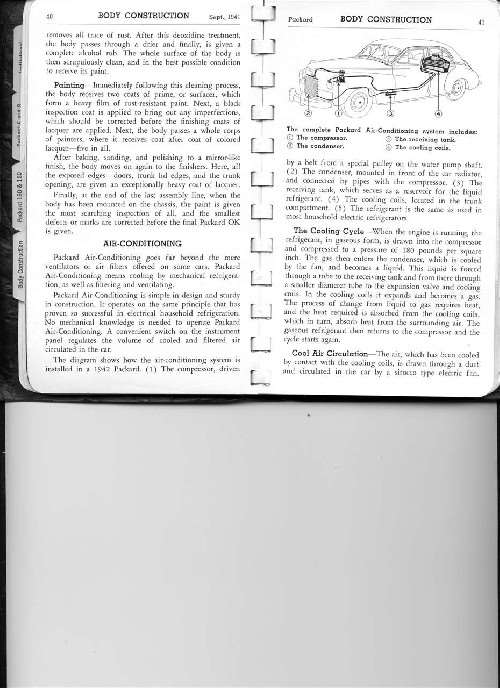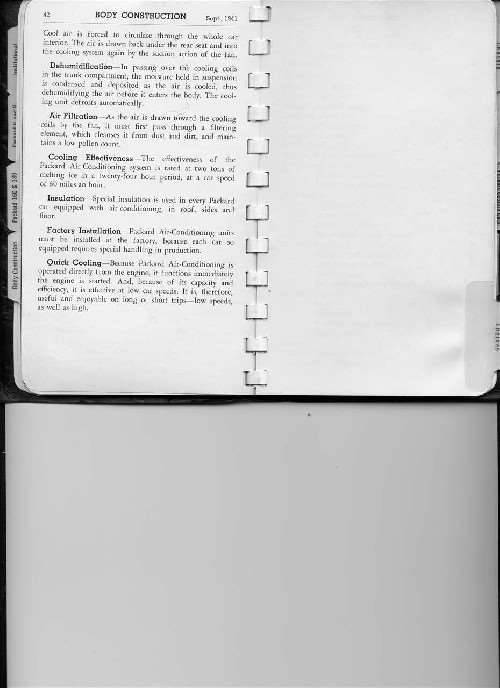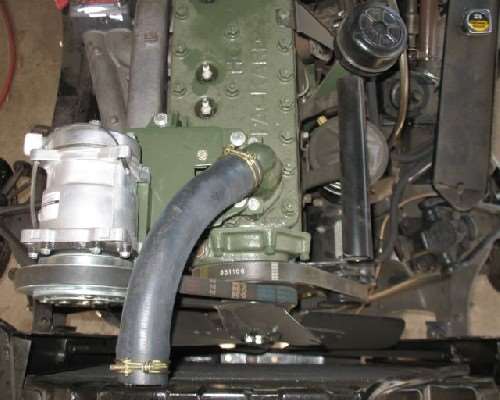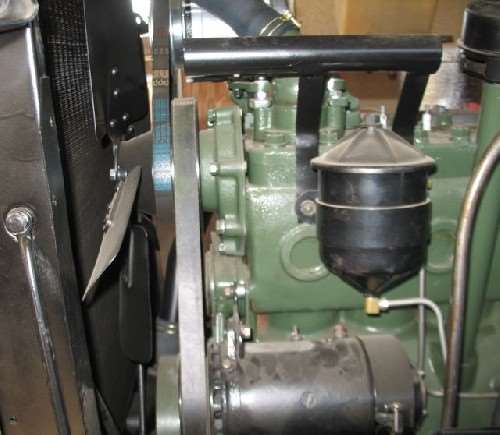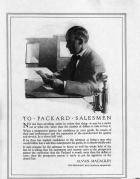|
Re: AC line routing.
|
||||
|---|---|---|---|---|
|
Forum Ambassador

|
There's a document on 1941 Packard Air Conditioning Operation, Service and Owner's Instructions in the site's archive that was filed with the 1940 Service Letters (and with filename coded for Vol. 14).
However, I believe this document was actually an insert to the 1941 Service Letters - per an article on 'Air Conditioing Instructions' in SL Vol. 15, No. 12. I indexed it as such under the Air Conditioning heading of the 37-42 installment to the site's Service Index - as 'SL Vol. 15, No. 8 (insert)'. Our scan also includes an updated page that was referenced in the later article. Among the pages of this document is an illustration of a sedan showing the general location of AC system components - including lines and their diameters. A similar illustration is provided for an article on 'Weather Conditioned Cars' in SL Vol. 14, No. 5, which also cites a separate parts list. Unfortuantely, I don't recall such a parts list in our arhcive.
Posted on: 2014/2/23 19:56
|
|||
|
||||
|
Re: AC line routing.
|
||||
|---|---|---|---|---|
|
Home away from home
|
Here is some information from the Body Construction section of the Packard Data Book for 1942 with a description and illustration of factory installed air conditioning as used on the Clipper bodies.
Posted on: 2014/2/23 19:57
|
|||
|
||||
|
Re: AC line routing.
|
||||
|---|---|---|---|---|
|
Forum Ambassador
|
Very Interesting. Looks like the compressor was on the drivers side in Clippers and line run down inside frame rail -- probably with with brake line and then crosses over.
I'm using a repro compressor mount for a conventional body so compressor is on the passenger side. Already finished with that part so don't really want to change it now. Will look into a different tubing route though and see how much of a problem it might be to get the tubing -- in particular the suction side -- over to drivers side. Conventional bodies ran a tube across the firewall but not sure I like that option. Any ideas on why they changed the compressor to the opposite side on Clippers and did they keep the 356 horizontal ventilation tube and oil filter in the same spot. Those items are awfully close to that compressor location. Thanks for the info from the fact book.
Posted on: 2014/2/23 20:30
|
|||
|
Howard
|
||||
|
||||
|
Re: AC line routing.
|
||||
|---|---|---|---|---|
|
Home away from home
|
As you're probably aware, the conventional body compressor location on the passenger side required a reroute of the heater line. The hard pipe "inboard" is replaced by a conventional rubber hose "outboard" passing through a clip on the inner fender
Posted on: 2014/2/24 9:57
|
|||
|
||||
|
Re: AC line routing.
|
||||
|---|---|---|---|---|
|
Home away from home
|
interestingly the conventional body shown with AC is a Junior
Posted on: 2014/2/24 10:02
|
|||
|
||||
|
Re: AC line routing.
|
||||
|---|---|---|---|---|
|
Forum Ambassador
|
Well, my three remaining active brain cells are stumped. AFAIK, the Clipper bodies and engine compartments are virtually the same pre and postwar. Would be interesting to know what and where Packard moved or sacrificed items to mount the compressor on the drivers side in a Clipper. If they moved nothing, it must be high and over the generator and horizontal tube. At any rate servicing the filter must be fairly interesting.
The Sanden compressor is small for the mount used so I am considering ditching the old conventional body repro mount and revising things to something along the clean lines Ross came up with. Possibly something could be done with the oil filter bolts and the thermostat housing bolts. Not sure the horizontal tube would stay though. Found a path for the tubing although looking at the drawing again, if it is accurate Packard seems to have done it differently than what I came up with. Maybe tubes are fastened to the floor rather than the frame. Photos would resolve many unanswered questions if anyone has any to share but AC Clippers must be few and far between. The previously mentioned fellow owning the Clipper didn't respond to my last inquiry so won't bother him again. If the car happens to show at Salado, would sure appreciate some photos.
Posted on: 2014/2/24 13:30
|
|||
|
Howard
|
||||
|
||||
|
Re: AC line routing.
|
||||
|---|---|---|---|---|
|
Webmaster
|
Post-War A/C had the lines running down the outboard side of the passenger frame rail I believe. This kept the lines away from the exhaust pipe and muffler.
Posted on: 2014/2/24 15:09
|
|||
|
-BigKev
1954 Packard Clipper Deluxe Touring Sedan -> Registry | Project Blog 1937 Packard 115-C Convertible Coupe -> Registry | Project Blog |
||||
|
||||
|
Re: AC line routing.
|
||||
|---|---|---|---|---|
|
Forum Ambassador
|
Quote:
You're right on the postwar cars. For the most part, I was planning to do it that way using the outer passenger side except for the bit that looked to be close to exhaust. When the drawing of the 42 Clipper was posted, plans changed. Have even revisited the earlier route using the drivers side frame. Will still use the drivers side but there is a nice clear path using the body cross braces for the support points instead of the frame. Maybe that is what Packard did. At any rate the new route on the body is shorter so saves buying some lengths of tubing. I think the compressor re-mounting on drivers side may also be figured out. In one of my more lucid moments when fabricating the initial passenger side I had actually made some things symmetrical. By flipping those over and adding a vertical piece, the comp can get above the horizontal tube and then out to still use the same belt. A second added piece down to the filter bolts should secure things. More on that change later -- if it works.
Posted on: 2014/2/24 16:12
|
|||
|
Howard
|
||||
|
||||
|
Re: AC line routing.
|
||||
|---|---|---|---|---|
|
Home away from home
|
Howard, if Terry brings his 41 AC equipped Clipper to Salado, I will certainly ask him for permission to examine and photograph the installation. I have found him to be friendly and cooperative and wonder why he has not gotten back to you.
(o{}O)
Posted on: 2014/2/24 18:05
|
|||
|
We move toward
And make happen What occupies our mind... (W. Scherer) |
||||
|
||||

 (137.42 KB)
(137.42 KB)